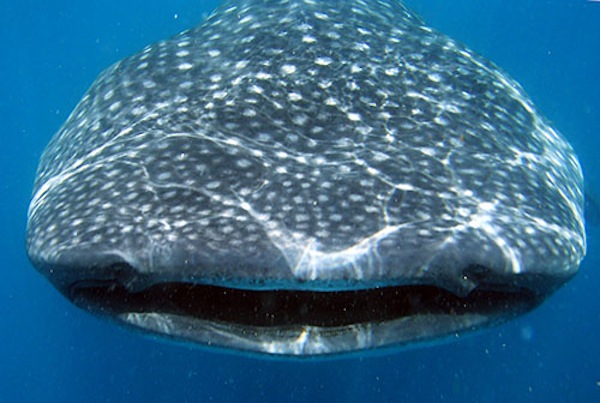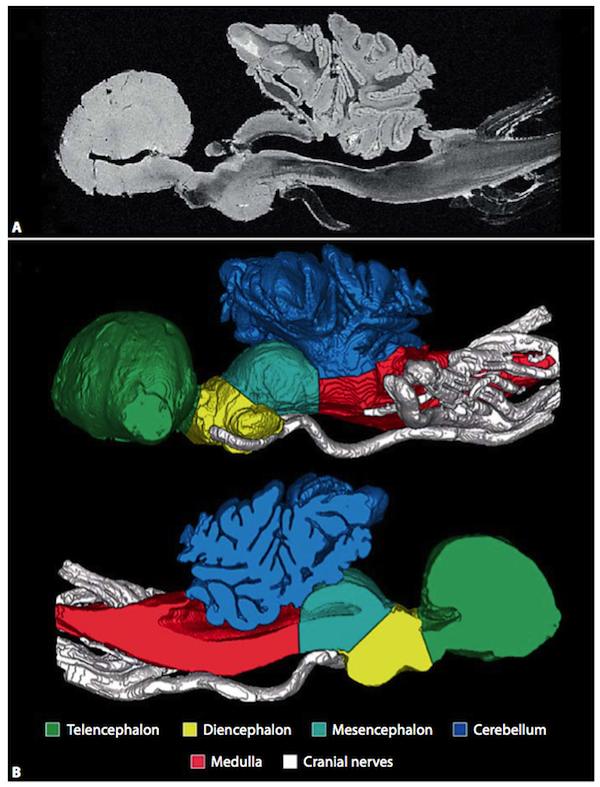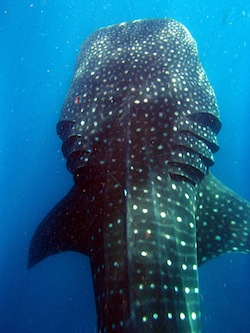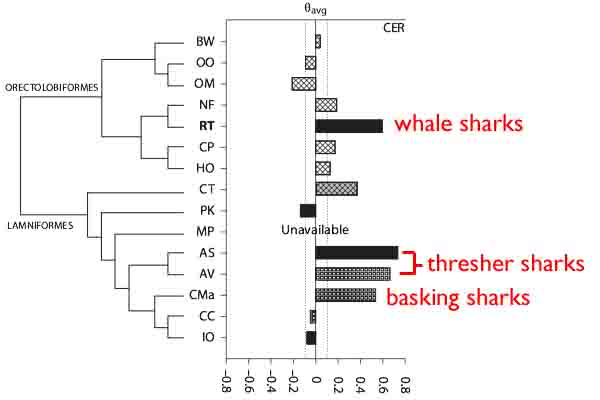

Shark Week is open us, and rather than be fooled by sharky fakery or outright lies, how about some real, true, scientifically-accurate shark science? Here’s a piece I originally wrote in August, 2012.
The largest fish in the ocean is the whale shark (Rhincodon typus). This massive, migratory fish can grow up to twelve meters in length, but its enormous mouth is designed to eat the smallest of critters: plankton. While the biggest, the whale shark isn’t the only gigantic filter-feeding shark out there: the basking shark and the megamouth shark also sieve enormous amounts of the tiny organisms from the sea in order to survive.
While scientists like Al Dove and Craig McClain (of Deep Sea News) are learning more and more about the basic biology and behavior of these magnificent creatures, other scientists are busy investigating their neuroanatomy. A few years ago, Kara E. Yopak and Lawrence R. Frank from the University of California in San Diego got their hands on two whale shark brains from an aquarium, and put them into an MRI scanner.
But they weren’t just interested in imaging the brains of the whale sharks. What they wanted to know was how the organization of whale shark brains compared to the brains of other shark species for which scientists had previously obtained neuroanatomical data. Would the brains of two species be more similar if they shared a recent evolutionary ancestor, and were therefore more genetically related? Or would shark brains be more similar among species that shared a similar lifestyle, such as those that patrol the middle and surface of the water column (pelagic sharks, such as the great white, oceanic whitetip, blue, mako, and whale sharks) versus those that live along the sea floor (benthic sharks, such as the nurse and cat sharks). Or perhaps the brains of sharks would be grouped according to their habitat, such as those that live in coastal waters, around reefs, or in the open ocean. Maybe shark brains ought to be grouped according to behavioral specialization, such as hunting methods. Answers to these questions could shed some important light on brain evolution, both in sharks as well as more generally.

An MRI slice through the center of a whale shark brain (top). The segmented view is shown from the exterior (center) and interior (bottom).
They found that – compared with other shark species – the brains of whale sharks were smaller than expected given their body size. The same is true for great white sharks, basking sharks, and sand tiger sharks. While those three species all belong to a group of sharks known as the lamniformes, whale sharks belong to a different evolutionary grouping called orectolobiformes. Interestingly, the habitat and lifestyle of the whale shark is also more similar to the lamniformes than it is to the rest of the orectolobiformes.
In this figure, adapted from Yopak Frank (2009), whale sharks (circled in red) have lifestyles and habitats that are unique for their evolutionary grouping.
By contrast, the closest genetic relative to the whale sharks that was included in the analysis – the tawny nurse shark, another of the orectolobiformes – had a brain that was larger than expected for its body size. Compared to its evolutionary relatives, the whale shark represented a decrease in brain size.
It has been suggested that large brains are correlated with increasing cognitive demands that a given species might face. Therefore, it is possible that the relatively smaller brains of the plankton predators were, as Yopak and Frank say, “related to their opportunistic passive predation strategies,” which is likely less cognitively demanding than more active hunting behaviors. Similar patterns have been found among birds, mammals, and other types of fishes as well: at first glance, neuroanatomy appears as if it might be tied to hunting behavior.
However, a closer look complicates the picture a bit. “One of the most notable characteristics” of the whale shark brain, according to the researchers, was its “large and highly foliated” cerebellum, compared with other species. Despite its smaller brain overall, the whale shark has a larger cerebellum.

A whale shark feeds vertically
The whale shark shared this characteristic with not with its own cousins, but with thresher sharks and basking sharks, again, both members of the lamniformes. In fact, the cerebellum accounts for between 28 and 32 percent of the brains of these species. It is generally thought that the cerebellum is involved in organizing motor programs, including maintaining awareness of motor coordination and correcting errors in the execution of motor commands. Useful skills for an active hunter like the thresher, to be sure, but how necessary are they for sharks like the whale and basking, that hunt by swimming with their mouths agape, passively straining the plankton out of the seawater? Hunting strategy might account for some of the variation in brain anatomy among sharks, but there’s clearly more going on.
Indeed, other shark species with similarly complex cerebellums are those that require high agility for prey capture, such as hammerhead and thresher sharks, but also basking sharks which, like the whale shark, are filter-feeders. However, the whale shark migrates over extremely long distances, and is also known to migrate vertically within the water column. It has also been observed suspending itself vertically to feed, a maneuver that requires a high level of coordination. The anatomy of the cerebellum, then, has less to do with hunting, and more to do with motor coordination requirements more generally.

In this figure, adapted from Yopak Frank (2009), whale sharks have similar cerebellar architecture to thresher and basking sharks, despite being phylogenetically distinct.
Ultimately, Yopak and Frank concluded that the brain was “more similar in species with analogous but independently evolved lifestyles than those that shared taxonomic classification.” In other words, at least among sharks, brain anatomy is defined more by the environment in which the shark lives, and by its lifestyle, than by genetic classification. The similar brains of whale and basking sharks, for example, are the result of convergent evolution. The two species independently evolved similar brains due to similar habitats and lifestyles, despite being separated by at least 289 million years of evolution.
As is the case for most scientific investigations, the questions are usually simpler than the answers. While something like hunting strategy may at least partially explain the smaller relative brain size of species like the whale shark and basking shark, other characteristics like the need for complex motor sequences seems to account for the relatively bigger cerebellums in those same species. Of course, something as complex as brain anatomy would be multiply determined. So the question simply becomes more nuanced: how do all those variables interact and combine to build a brain? Given the vastly disparate environments that they inhabit and distinctive behaviors that they display, sharks will continue to serve as useful model species as we strive to answer that question.
Yopak KE, Frank LR (2009). Brain size and brain organization of the whale shark, Rhincodon typus, using magnetic resonance imaging. Brain, behavior and evolution, 74 (2), 121-42 PMID: 19729899
Images: Header image of “smiling” whale shark, and image of vertically feeding whale shark both by Dr. Al Dove, used with permission.
